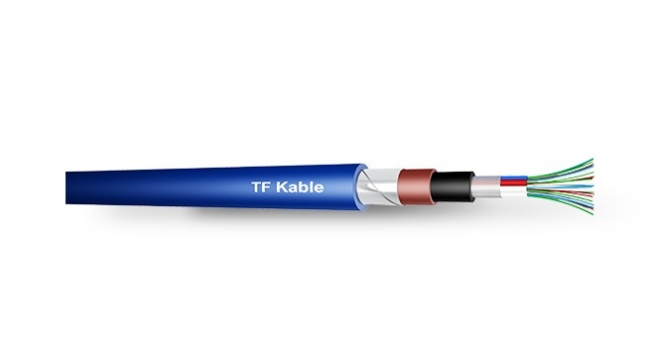Fibre optic cables contain fibre optics, which are a medium to transfer a signal, in this case, electromagnetic wave in the infrared range. As such, they are resistant to electromagnetic interference, and their special feature is the ability to transfer data with huge throughput, up to hundreds of Gib/s.
Detailed construction of a fibre optic cable depends on the specific application (method and place of installation, and the distance at which transmission will occur), but in general, there are several components:
- optional central element,
- fibre optic,
- protective tube,
- sealing,
- optional reinforcement,
- external cover.
Depending on the number of sent fibre optic modes (waves), fibre optics are divided into single-mode and multi-mode.
Single-mode optic fibres are characterised by low dispersion and attenuation, making them suitable for transmission at long distances. Due to the minimum attenuation, in telecommunications a wavelength of 1550 nm (III transmission window) and 1310 nm (II transmission window) is used for transmission. Single-mode fibre optics allow transmission in xWDM technology, enabling throughput of Tib/s.
In fibre optic cables produced by TF Kable, single-mode fibre cables comply with the requirements of ITU-T:
- G.652D - single-mode with lower water peak (mark J),
- G.657A1, G.657A2 - single-mode with reduced bending radius (mark J657A1),
- G.655 - single mode with non-zero shifted dispersion (mark Jn).
Multi-mode fibres carry a number of light modes. Because of the dispersion, they are mainly used to transmit at a short distance, e.g. within one building. Wavelengths of 850 nm and 1300 nm are used.
Characteristics of the multi-mode cables include a diameter of the fibre core and a covering protective layer (so-called coat), e.g. fibre marked as 50/125 has a core with a diameter of 50 μm and a coat with a diameter of 125 μm. G 50 mark is used as an alternative. 62.5/125 is another common multi-mode fibre, alternatively marked as G 62.5.
Due to the construction and application of fibre optic cables, they can be divided into:
- internal - used inside buildings or structures, e.g. tunnels
- external - used outside buildings. This category includes self-supporting cables, cables used in sewerage systems, and cables of special purpose.
- universal - due to their design, they can be used both in internal and external systems
- special application cables


